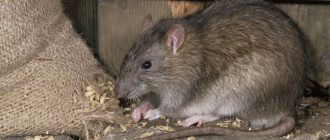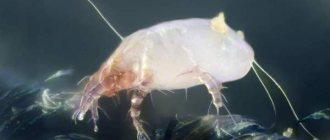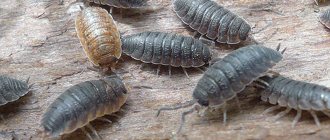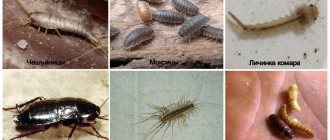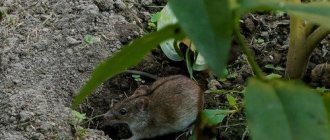home/
Garden pests
/
Spider mites: why is it dangerous and how to get rid of it?
- Spider mites: how to detect the pest? Appearance
- Habitat of the spider mite
- Common types of spider mites
- Reproduction of spider mites
- Spider mites on cucumbers
- Chemicals against spider mites
Spider mites (Tetranychinae) are a fairly common pest that destroys plantings at tremendous speed. This arachnid is difficult to notice in the early stages due to its small size. It multiplies quickly, moving from one plant to another.
How to get rid of it?
You can fight these insects using different means.
The easiest way to get rid of pests is natural cleaning, which involves regularly washing and wiping the flowers. To do this, use plain water to which a few drops of mild dishwashing detergent are added. A sponge is moistened in water and individual leaves are wiped with it, after which water is sprayed from a spray bottle throughout the plant, especially trying to get on the lower part of the leaves. The tray, pot and window sill should also be treated. If after a week the spider mites do not disappear, the soap solution is applied again. Not all plants tolerate this product equally well, so it is necessary to test the flower before applying it. To do this, apply a soap solution to a small part of the leaf and monitor the reaction.
Since spider mites do not tolerate high humidity, you can fight them with frequent watering and spraying of the flower. After each moistening, the plant is covered with a transparent bag and left for several days. In conditions of high humidity, the insect dies. To prevent the greenhouse effect from occurring and the flower not to get sunburned, it should be placed in a shaded place.
Preparations such as acaricides help rid the plant of this small pest.
But it is necessary to treat flowers with this product very carefully, because it is unsafe for people and animals. Gentle acaricides include:
- "Fitoverm";
- "Vermitek";
- "Aktofit".
Such preparations help destroy sleeping female spider mites and eggs of future larvae, so they are used repeatedly to achieve the desired result. If the room temperature is below +18 degrees, these drugs will be ineffective.
The plant can be sprayed with chemicals such as:
- diphocol;
- dienochlor;
- azocyclotine;
- phenbutatin.
It is not recommended to use the same product more than four times, as spider mites begin to get used to it and develop immunity.
You can make your own special herbal tea at home, which is used as an acaricide. To do this, take 1 tbsp. l. ground cinnamon, 1 tbsp. l. ground cloves and 2 tbsp. l. Italian seasoning. All ingredients are mixed and poured into 1 liter of water, then brought to a boil, cooled and 2 tbsp added to this mass. l. chopped garlic. Strain, after which liquid soap is added to the tea and poured into a spray bottle. This solution is sprayed on the lower part of the leaves every three days for two weeks.
Essential oils and organic salts work well against spider mites at home. Rosemary oil is used as an organic pesticide. It is necessary to dissolve a small amount of oil in water and spray it on infected flowers. The peculiarity of this product is that it has a detrimental effect on ticks, but leaves other insects alive.
Potassium salts and fatty acids have abrasive properties. They must be used in the evening so that the flowers remain moisturized longer.
The following insects are considered good helpers in destroying spider mites:
- ladybug;
- predatory thrips;
- lacewing larva.
Since pesticides kill all insects in a row, the spider mite population begins to grow because of this. Therefore, it is better to avoid using pesticides such as imidocloprid, malathion and carbaryl.
Sources of contamination of home greenhouses:
- buying a new plant, and with it “moving” into the house of parasites;
- blown by the wind - the fault will be an open window or loggia;
- spider mites can get caught on clothing, shoe soles, or the fur of a domestic cat or dog;
- The soil taken from the flower bed may be contaminated;
- “web spider” eggs remain viable for 5 years, so it is necessary to thoroughly rinse and disinfect cache-pots, pots, and trays;
- the pest becomes active if the flower is not watered enough in dry and hot room conditions: it begins active oviposition - one female is capable of producing 250-300 eggs in two to three weeks.
Preventive measures
Almost all types of ticks, with the exception of a few species, cannot tolerate excess moisture. Many gardeners focus on this feature and successfully prevent the appearance of the parasite.
With proper care of indoor plants, it is possible to quickly recognize this dangerous pest and destroy it in time. Therefore, there are proven methods for preventing the appearance of various parasites. For example:
- Every three days it is recommended to wipe the leaves of indoor flowers and other ornamental plants with a damp cloth. To do this, you need to take hot water and rinse the rag well each time.
- Do not allow the soil to dry out.
- Constantly remove fallen leaves from the flowerpot, which can serve as a hiding place for ticks.
- Flowers are regularly fertilized and the desired temperature and humidity are maintained. If the plant is strong and healthy, then even ticks may find it too tough.
Novice gardeners believe that they can get rid of mites if they completely immerse the plant in water. Actually this is not true. Firstly, you can damage the flower itself, and secondly, an air bubble forms around the mite. Of course, if you keep a flower in water for several hours, the effect will be obvious, but it is unlikely that any flower will be able to withstand this. The most effective way is to wipe the leaves with hot water, but this method will not be effective if many spider mite colonies are found on the plant.
In order not to spend a lot of effort and energy fighting flat pests, it is better to adhere to certain rules for caring for indoor plants. If you really like flowers so much and can’t live without them, then you need to care for them properly.
The danger of mites for indoor plants
To understand why this pest is dangerous, it is necessary, first of all, to understand: what does the mite do when it settles on plants? Living on the leaves, it slowly feeds on the liquid component of their cells, gnawing holes. Because of this, the leaves change color, and over time they begin to dry out and die.
A plant infected with spider mites
This type of mite was called spider mite because the pest entwines the leaves affected by it with a thin cobweb
If you do not pay attention to this and do not take timely measures, the plant is doomed to death.
Also, most ticks prefer to destroy plant flowers. Their favorite flower is the indoor rose. Having settled on it, the mite gradually destroys all the beauty, harming the decorative properties of the indoor plant. These are the main signs of mites appearing on plants. If you notice any deviation from the above, immediately begin fighting the pest. So, you found spider mites on your indoor flowers: what to do next?
What plants does the pest attack?
Spider mites are unpretentious eaters. However, the first on the list of his favorite crops are cucumbers, tomatoes, peppers and pumpkins. Insects also love sweet berries: raspberries, strawberries, currants and grapes. Apple trees, pears and apricots also cannot withstand his destructive interest. And even decorative flowers such as roses, callas, fuchsias and cyclamens cannot safely exist with it in the same area.
Prevention measures
The main factor in the appearance of spider mites is dry air, so the best prevention is to spray water on the plants during dry weather. In this case, you need to ensure that water does not accumulate in the core of the stem.
Pay special attention to plants in the winter season, as due to shorter day lengths and low temperatures, water evaporates slowly. To get rid of the parasite, the plant should not be immersed in water, since when it comes into contact with water, the mites develop armor in the form of air bubbles
To get rid of the parasite, the plant should not be immersed in water, since upon contact with water, the mites develop armor in the form of air bubbles.
A homemade solution will help prevent infection.
- To prepare it, you need to mix 20 g of cinnamon, 40 g of Italian herbs, add 1 liter of water.
- Boil, cool and add 40 g of chopped garlic.
- You can also add 2-3 drops of soap.
For preventative purposes, treat the leaves every 2 days for 2 weeks.
Nuances of prevention on site:
- Regular cleaning of garden tools with disinfectants.
- Deep digging of the soil in the fall.
- During the fruiting period - regular weeding and subsequent loosening.
- Compliance with crop rotation tips.
- Regular watering (as the earth crust dries), mulching the soil.
- Inspect leaves daily for infection. If traces of the parasite are found, cut off the infected leaf and burn it.
Getting rid of spider mites can be a long and frustrating task. Try not to create conditions that have a beneficial effect on the reproduction of the parasite (heat, moisture, dryness).
At home, do wet cleaning, follow sanitary standards, wipe dust not only on cabinets, but also on leaves. Ventilate the greenhouse regularly and get rid of weeds on time.
Chemical and biological preparations for plant treatment
Methods to combat spider mites include the use of improvised means and specially developed preparations. The first option is environmentally friendly, but in case of severe infection it is not effective. At the first sign of a pest, it is recommended to treat all plants with a soap solution (100 g of laundry soap per 10 liters of water). Infusions of onion peels, garlic and tobacco are used.
Eco-friendly and safe methods of destroying phytophages include the use of the predatory phytosailus mite. It is enough to place 60 individuals per m2 of land to get rid of eggs, larvae and adult pests. Acarifage is active at temperatures above 200 and high humidity. After removing all enemies, the predator will die without food.
Chemicals are much more effective in the fight to preserve the crop. Many means have been created that can destroy the pest at various stages of development.
- Karbofos is an organophosphate substance, insecticide and acaricide. Available in various forms and concentrations. The active ingredient malathion is effective against insects and arachnids. The duration of protection in open ground is 10 days, in a greenhouse – up to 7 days. Spraying is carried out in the evening in calm weather.
- Actellik is a spider mite remedy suitable for use on open and protected soil. The drug is an insectoacaricide; it does not affect the plant, it only poisons pests. The enteric-contact substance has fumigant properties, destroying phytophages on both sides of the leaves. Duration of exposure is 2-3 weeks.
- Apollo - the action of the acaricide is aimed at eggs and larvae. This drug is one of the few that can cope with pests at an early stage of development. The active compound clofentesine sterilizes adults, preventing reproduction. Apollo is a contact acaricide; to poison eggs, it is necessary to thoroughly moisten the plants with a freshly prepared solution. The substance is slightly toxic, safe for people and insects. The drug protection lasts up to 2 months.
Attention. When crops are treated with one chemical, pests become addicted. During the summer season, it is necessary to change the means of destruction.
Spider mites
Tetranychus telarius form a web, but the gardener cannot always see it right away. Sometimes it is so small and thin that it is clearly visible only when there is a huge concentration of mites, or when the plant has already completely dried out. Therefore, when you find suspicious spots on the leaves, do not try to look for cobwebs, look for the skins that remain from molts - they are usually gray or almost white, you can see them on the back of the leaf, they look like fine dandruff. This is due to the fact that the common spider mite lives mainly on the back side of the leaf, and weaves a web between the veins; if you look closely, you can see it with a magnifying glass along the central vein. But if nothing is found, this does not mean that there are no ticks.
Common spider mite under a microscope.
The web is visible between the leaf blade and the central vein.
The skins on the back of the sheet are white.
Characteristic signs of damage: if the leaf is exposed to light, pinpoint punctures, whitish or yellowish, are visible. At first there are few of them, but gradually they merge into spots. The leaves turn pale and acquire a grayish or pale yellow tint. Then the leaves dry out and completely lose color. This is a typical pattern, but in some cases the leaves turn red or take on a bronze tint. In some plants, the leaves do not change shape even when the spots are large, in other cases they are severely deformed and curled.
Continue to inspect the plant every day, because under favorable conditions, mites multiply rapidly. During two to three weeks of life, under favorable conditions, the female lays over 150-200 eggs. The duration of generation is 2-3 weeks, at the same time all stages of development are present on the plant: eggs, larvae, nymphs, females and males. The entire path of metamorphosis (from larva to adult tick) at an average temperature of 20-24°C usually takes no more than 10 days; at temperatures above 32°C, the regeneration rate is reduced to a week. The rate of “maturation” of a tick egg is 1-3 days.
Mature individuals have a greenish color and are hardly noticeable on the leaves. With the reduction of daylight hours (from August), in dry, hot weather, females appear, preparing for winter. They stop feeding on the sap of the plant, acquire a red-brownish color, and look for more secluded places where they can hide (in the upper layers of the soil, under fallen leaves, in cracks in the bark). At the same time, females secrete a large amount of cobwebs, this is especially noticeable on garden roses - in a few days they become entwined with cocoons of cobwebs. If the temperature does not drop below 10-12°C, then spider mites will not overwinter, but will continue to actively reproduce (this is the minimum temperature at which the life activity of mites still continues). It’s sad that even prolonged freezing does not kill spider mites. Mite eggs can survive in soil or other hidden places (for example, straw, compost heap, window frame cracks) for years.
On plants with dense leaves (citrus fruits), only vague yellow spots are visible on the outside.
On plants with more delicate leaves (balsam in the photo), the leaf is translucent, traces of the mite are visible right through.
Mites especially love roses; we can say that the concepts of “roses” and “mites” are inseparable. There is nothing left to treat here.
Six-legged mites
Phytoptipalpus paradoxus is another subfamily of tetranychid mites, distinguished by the fact that they have only three pairs of walking legs. These types of herbivorous mites were formed in the process of evolution. The fact is that the formation of the cuticle and hatching from the egg in ticks occurs at a time when the fourth pair of legs has not yet developed in the embryo. A six-legged larva hatches with a shortened abdomen - the last segments and genital valves are underdeveloped. As a result of mutations during evolution, some adults developed a normal abdomen, but the last pair of legs never developed. As a result, the trait was fixed, and a subfamily of six-legged spider mites was formed. All of their three pairs of legs are very short, and their body is much wider than that of an ordinary spider mite, almost round. Six-legged ticks do not have a prelarval stage in their life cycle.
Appearance and features
Photo: What a spider mite looks like
The entire body of the spider mite is enclosed in a structured thin or more dense cuticle with folds, points or tubercles. Covers of a denser cuticle can form peculiar shields. The body color of ticks, depending on their species, can be translucent, yellow-green, orange, bright red. Regardless of the color of the body, its internal organs are always visible through the outer covering of the insect in the form of a darker spot.
Adult ticks and nymphs have four pairs of thin legs, while larvae have only three. At the ends of their legs they have complex claw-shaped devices. With their help, mites cling tightly to stems and leaves. The genital organs of female ticks are located on the abdomen, while those of males are located in the back of the body. The mouthparts of these insects are of the piercing-sucking type and are well adapted for quickly piercing the skin of plants and sucking up the secreted juice.
The gland responsible for the production of the web is located on the head (only in females and nymphs) and is located inside short segments (pedipalps), which are fused during the process of evolution. On the second body segment from the head, ticks have four simple red eyes that react exclusively to short waves of the light spectrum.
Now you know what measures are available to combat spider mites. Let's see where this insect lives.
Signs of plant damage
Experts call the spider mite an ideal pest. It is capable of reproducing very quickly, is omnivorous, and at the same time easily goes into diapause if conditions are not too favorable for life. Clutches left by the female and covered with cobwebs can be found on the walls of containers, on the leaves below, as well as in the ground itself. The eggs have a smooth shell. They can remain viable for several years, without dying due to unfavorable conditions, but simply slowing down their development.
If the damage is very severe, the plant will be noticeably shrouded in such a net that collects dust and excrement of these small animals. However, some varieties of the pest practically do not weave webs.
Another sign of infection are eggs, but it should be noted that they are very difficult to see. The fact is that the diameter of each is less than a millimeter, in addition, they are very light or even translucent. They are located in small groups, from 1 to 3 eggs in each, and are covered with a protective layer of cobwebs, creating the most suitable conditions for development. It takes 3 days for the larvae to appear.
This mite eats plant sap. He can get it from anywhere in the flower. Small light spots appear on the affected area; they are best seen on the leaves. This leads to a slowdown in photosynthesis and disruption of intercellular structures, respectively, their proper functioning becomes impossible.
These spots grow over time and lead to yellowing of the leaves. They dry out in small areas and also become sluggish and inelastic. A coating of cobwebs forms on top.
Finally, the last stage can be called the falling of leaves. The spots on their surface join together, the leaf blade dries out and falls off. The more pests there are on a plant, the faster they can destroy it.
Signals from the web crawlers:
- it was as if a needle had been passed over the leaf plate. Such “injections” are easy to see in the light;
- on the rosette of leaves, small brown spots are noticeable, which then spread out more and more, forming ever larger lesions;
- the crown and flower stalks dry out and fall off;
- the plant stops developing;
- the flower is entangled in a web.
Leaves of a plant damaged by spider mites
Traditional methods of fighting spider mites
Folk remedies are widely used in the practice of getting rid of pests, since they are accessible and not as dangerous as chemicals.
Alcohol
Alcohol treatment is suitable for plants with large leaf blades. With this method, the leaves affected by the pest are wiped with a cotton pad moistened with a cotton pad or an alcohol wipe. It does not cause burns, as it quickly evaporates without causing any harm. The method is quite effective.
Colloidal sulfur
A 1% emulsion is made from sulfur powder or paste with the addition of water. For better adhesion, you can replace water with a soap solution. It is advisable to carry out the treatment by wetting, since the emulsion particles do not dissolve and will clog the sprayer hole. After a couple of days, the white coating is washed off with running water.
Kerosene
You can add a small amount of kerosene to the soap solution and treat the plant with this composition. Then it is washed with running water.
Tobacco infusion
For 1 liter of boiling water take 50 grams of dry raw materials or tobacco dust. The prepared, strained infusion is sprayed onto the plants from a spray bottle.
Safety precautions when treating with insecticide
I take the treated plants outside in the summer or into the bathroom if the treatment takes place in the cold season. You cannot spray Actellik in the presence of children and animals, since it is a hazard class 3 drug. Smoking while spraying is strictly prohibited.
- Tinder fungi on walnuts - why they are dangerous and how to get rid of harmful mushrooms
In order to protect myself from the toxic effects of the drug, I wear gloves, a cotton respirator from a hardware store and a thin polyethylene raincoat. After treating the plants, I thoroughly wash the bath with soap, rinse with running water from the shower, throw away the mask, gloves and cape and take a shower.
In particularly advanced cases or for your own peace of mind, repeat the treatment after 10-12 days. And don’t count on the fact that ticks won’t appear again: you need to be very careful with these pests.
More information about spider mites
Flat beetles
Tenuipalpidae - or false spider mites (not to be confused by name with the flat beetle Cucujidae), of the genus Brevipalpus Brevipalpus and Tenipalpus Tenuipalpus. They are very similar in size and shape to spider mites; they also sit on the underside of leaves and move slowly. Their sizes are very small, from 0.1 to 0.4 mm.
If these images are not enough for you, you can also look at the spider mite photo.
In many species, colonies consist only of females, which hatch from unfertilized eggs. Development occurs in three stages: larva, protonymph and deutonymph. Maturation from egg to adult tick takes 12 to 24 days. The eggs of some species of flat beetles can be seen with the naked eye and appear as clusters of reddish-orange color. Larvae of flat beetles are six-legged, orange-red, translucent, nymphs are opaque, and dark spots appear on the body. Adult ticks are brown, eight-legged, and have a flattened body. Adult females live for 5 - 6 weeks, producing 6-10 generations per season. Many flat beetles have a pause (rest) of 1-2 days between moults; during this time they do not feed and remain motionless on the leaves.
The flat beetles are brown, but very small, looking like brown grains.
The puncture sites where the flat beetles are attached are dark dots.
Flat beetles do not form webs. They do not suffer from high humidity.
Plants affected by flat beetles differ in the nature of their spots. The fact is that most flat beetles have toxic saliva, which, when it enters plant tissue, causes necrosis. Therefore, brown or gray-brown spots appear on the upper side of the leaf. First small, pinpoint, 1-2 mm, then increasing in size. Leaves are often deformed, and in plants with dense, fleshy leaves (Saintpaulia, Gloxinia), the edges of the leaves begin to turn inward.
Worst of all, flat beetles are the main carriers of viruses (mosaic and ring spot). But what’s even worse is that the ideal conditions for the reproduction of flat beetles are a temperature range of 25-30°C and fairly high air humidity, at least at 70-80% air humidity they are comfortable, while spider mites at such humidity inhibit their development .
Dependence of the rate of mite metamorphosis on temperature:
- at an ambient temperature of 15°C: eggs mature in about 2 weeks, about another week for each subsequent stage: larvae, pronymphs and deutonymphs, a total of 33-36 days from egg to adult.
- at an ambient temperature of 20°C: eggs mature for about a week, about 3 more days for each subsequent stage: larvae, pronymphs and deutonymphs, a total of 2 weeks from egg to adult.
- at an ambient temperature of 30°C: eggs mature in about 3 days, about another 1.5 days for each subsequent stage: larvae, pronymphs and deutonymphs, only a week from egg to adult.
Development timeframe
The duration of the life cycle depends on the ambient temperature. At 20°, the tick goes through all stages of development in 20 days, at 25° - in 10-12 days, at 30-32° - in 5-6 days.
How long does an adult spider mite live? Under favorable climatic conditions, without falling into diapause, an adult individual exists from 16 to 30 days .
Where does the parasite spend the winter? When the temperature drops below 18°, spider mites enter diapause , having previously found a quiet, secluded refuge.
It can be:
- Plant residues - tops of cultivated plants, weeds.
- The top layer of soil - the tick can hide to a depth of 20 cm.
- Bee hives.
- Parts of greenhouse structures.
- Fences and storage boxes.
Signs of appearance on the plant
The body size of the animal (this is not an insect, it belongs to the arachnids) is from 0.2 to 1.2 millimeters, rare species reach 5 millimeters. In most cases, it is difficult to notice an emerging pest; it is usually identified by the changed appearance of the plant. Ticks are dangerous due to their short life cycle, which lasts only 8-40 days. Within 7-8 days, the egg develops into an adult, ready to reproduce. Adult ticks have 8 legs; body color varies among species from whitish and yellow to red-brown.
The female makes clutches on the lower part of the foliage, in the ground, on the walls of pots. She covers them with cobwebs. The eggs are well protected by a smooth shell; under unfavorable conditions they do not die, but slow down their development, remaining viable for several years. Nature has created an ideal pest - it reproduces quickly, goes into diapause under unfavorable conditions, and eats everything. A spider mite infestation can be identified by the appearance of the affected plant.
Eggs
It is difficult to notice tick eggs; their size is less than a millimeter. They are white or translucent, covered with a dense shell. The female arranges them in small groups (1-3 pieces), braids them with a web to protect them and create favorable conditions for development. The larvae appear within 3 days.
Thin cobweb
The main sign of the appearance of a mite is the web, which is woven en masse by adults in the lower part of the foliage. Colonies of eggs, larvae and mites are hidden under its accumulations. Some species of these arachnids hardly weave webs.
Yellowing of leaves
The tick feeds on plant sap, sucking it out from anywhere on the ground. A small white spot forms at the puncture site, best visible on the leaves. Cells stop functioning normally, photosynthesis slows down, and the conductivity of intercellular structures is disrupted.
Small specks grow, the leaf dries out in separate areas, turns yellow, becomes lethargic, and loses turgor and elasticity. The indoor plant takes on an unhealthy appearance - the leaves are yellow and limp, entangled in cobwebs.
Falling and dry leaves
Loss of foliage is the last stage of infection. Individual spots on the plates join together, the sheet dries and falls off. When photosynthesis is disrupted, plant defenses are reduced. Large colonies of mites literally suck all the strength out of the flower. They attack ovaries and buds, deforming even strong stems. Only one skeleton remains of the flower.
Origin of the species and description
Photo: Spider mite
Spider mites belong to the phylum arthropods, class arachnids, subclass mites. These are very small (0.2-1 mm) arthropods that feed on plants. Their sexual dimorphism is well expressed: females are significantly larger than males and have a more rounded body; males are correspondingly smaller and have a more elongated body.
The appearance of adult individuals is characterized by a solid body structure. Their body, unlike larvae and nymphs, is only conditionally segmented, and traces of dismemberment are noticeable only in the arrangement of the setae (Hittites). The bristles perform a tactile function and are arranged in transverse rows. They are very diverse in their shape, depending on where they are located (on the crown, on the back, on the lower back, on the sacrum, on the tail).
Video: Spider mite
There are several types of spider mites:
- ordinary - affects almost all types of plants;
- red - feeds on all nightshade crops, as well as citrus fruits;
- hawthorn - lives on fruit trees, both stone fruit and pomaceous (plum, cherry, sweet cherry, peach, sloe, apple, pear, hawthorn);
- Turkestan - a polyphagous parasite that attacks leguminous plants, stone fruit and pome fruit trees;
- cyclamen - lives only indoors or greenhouses, you will not find it on the street; settles on cyclamen, geranium, chrysanthemum, gloxinia, balsam;
- gall - prefers to settle on young leaves, in the process of its life activity it forms peculiar warts (galls) on them;
- root (bulb) - lives inside flower bulbs, feeding on their tissues;
- wide - prefers to settle on citrus fruits, cacti, ficus, Saintpaulia, aucuba;
- false - lives only in greenhouses, very small (0.3 mm), does not spin webs.
Interesting fact: Recently, scientists discovered several species of ticks of the superfamily Tetranychoidea, and among them no males were found.
Pest control methods: what products can be used, processing features
At home, it is difficult to use agrotechnical and biological methods for destroying arthropods. Acaricides or folk remedies are mainly used. In addition, if a mite appears on flowers, and other control methods do not help, consider replanting with a complete replacement of the soil (removing only the top layer is impractical). The flower is washed.
At the initial stage, you can remove leaves where pests live and signs of infestation have appeared. In addition, it is necessary to disinfect the tray, all containers, as well as surfaces around the area where the plant is affected. Curtains can also harbor parasites.
Chemical
Possible methods of delivering a toxic substance to the ground parts of flowers:
- soaking in solutions containing acaricides;
- spraying the product with a spray bottle;
- applying the substance to all leaves using a rag.
Chemicals are sprayed using a spray bottle.
Table: Examples of chemicals used on indoor plants. How do they work, how much do they cost?
Signs of spider mites on indoor plants
You can understand that a parasite has appeared by a number of nonspecific signs:
- white inclusions over the entire surface of the leaves at the initial stage of development of the disease; they arise as a result of the introduction of the most protruding part of the oral apparatus into the plant tissue;
- spots of a different shade (light, brown) form - a sign of a violation of internal processes;
- young flowers stop growing;
- the shape of the leaf and its texture change;
- flowers fall;
- leaves dry out;
- on the back side you can see white formations - pest eggs, they are microscopic (less than 0.2 mm).
Thus, the appearance of arthropods is assumed if a web is noticeable (one of the main specific signs). Also at the bottom of the sheet, moving microscopic dots (less than 0.5 mm) are striking. This is an imago, the offspring of arthropods that are much smaller.
White cobwebs on indoor plants
Fine fibers can be seen between the stem and the base of the leaves. The threads are white, the web itself is transparent. It is formed due to the release of a special secretion, which instantly hardens. This leads to the appearance of threads. The cobwebs become noticeable when there are a lot of flower mites.
In the last stages of the development of the disease, parasites can be seen crawling along this mesh, which allows you to immediately determine the cause of the deterioration of the flowers.
When there are a lot of ticks, the web is more noticeable
White spiders on indoor flowers
The shade of the outer coverings of ticks varies from light yellow to brown. There are green and red pests. Color helps to identify the type of parasite, since there are a large number of individuals representing the general group of spider mites. In addition, traces of pest habitat remain on the leaves: shells that are shed by larvae and nymphs during the molting process; they are light in color; waste products in the form of tracks with a silvery tint, white spots.
Color may vary depending on the age of the spider mites.
Pest on vegetables - how to fight?
The spider mite has preferences among vegetable crops; most often it chooses cucumbers, melons, eggplants, and peppers. Phytophages feel especially good in a greenhouse. Here they are protected from bad weather and temperature fluctuations. A high reproduction rate under favorable conditions leads to rapid infection of all vegetables.
The result of the pest’s activity is:
- mechanical damage to the back of the leaves;
- slowing down the development of the ovary;
- when a spider mite appears on cucumbers, the upper tier of the plants becomes entwined with cobwebs;
- photosynthesis processes are disrupted;
- necrosis develops, the plant becomes deformed and dries out;
- Productivity declines catastrophically.
Attention. The natural enemy of the spider mite, Phytoseiulus persimilis, is used in greenhouses to kill pests. The predator feeds exclusively on this species; it is absolutely not dangerous to plants and humans.

